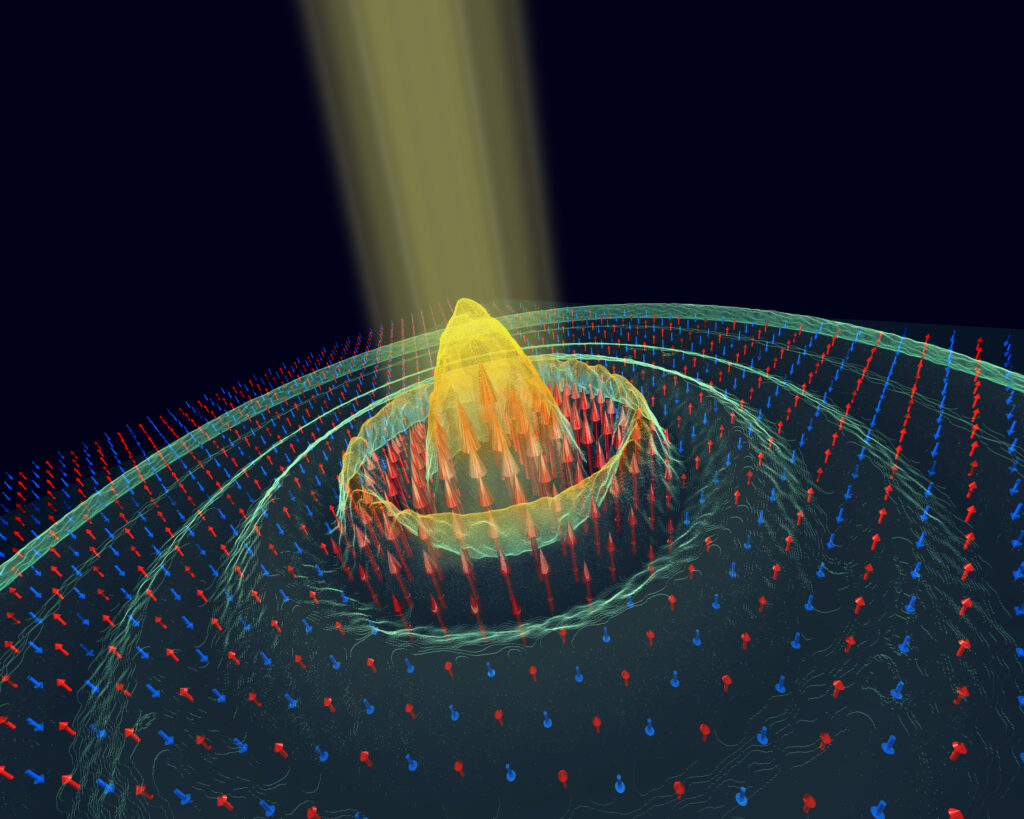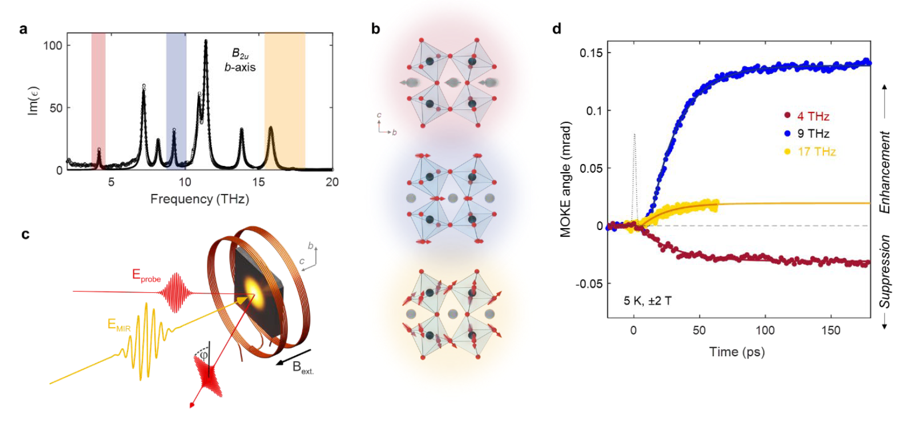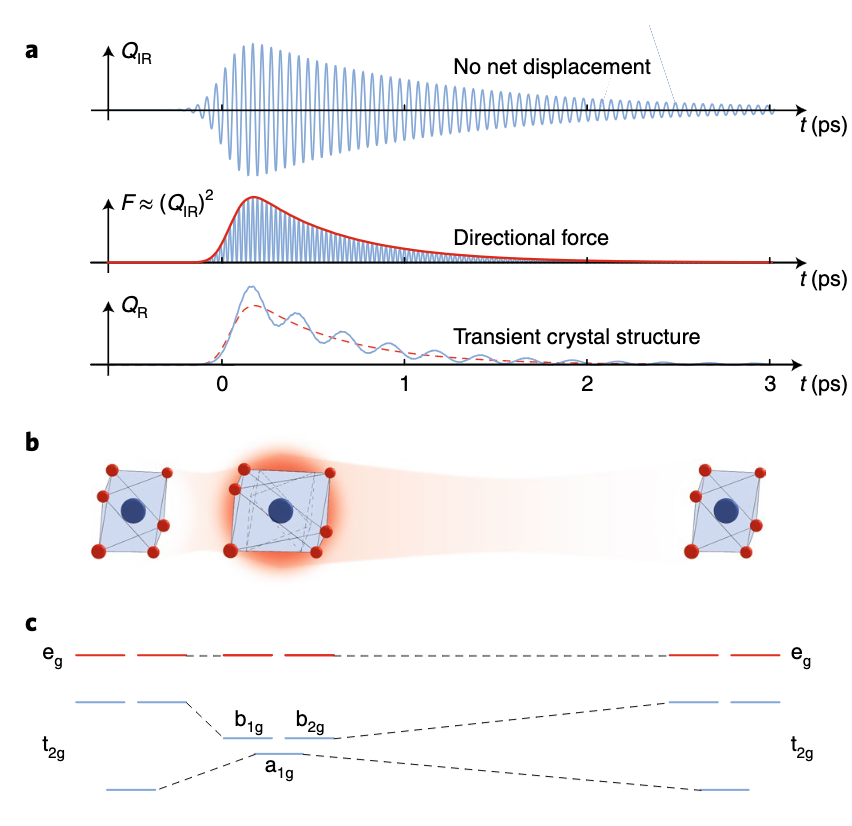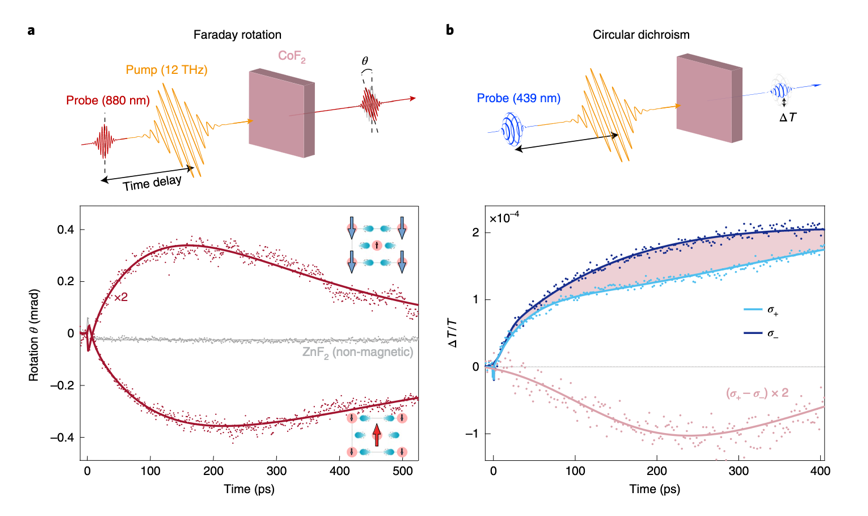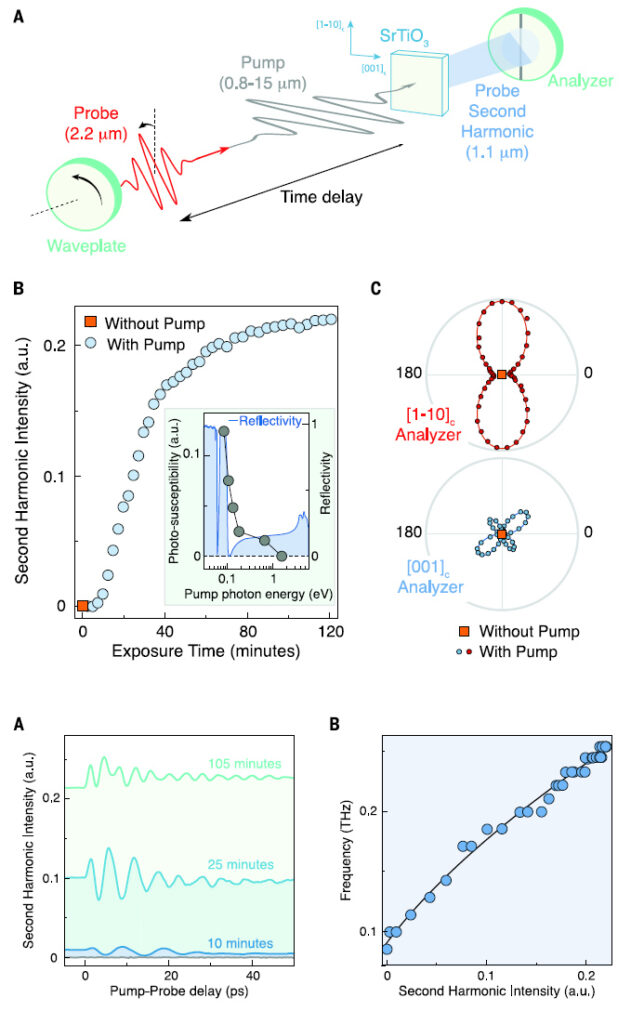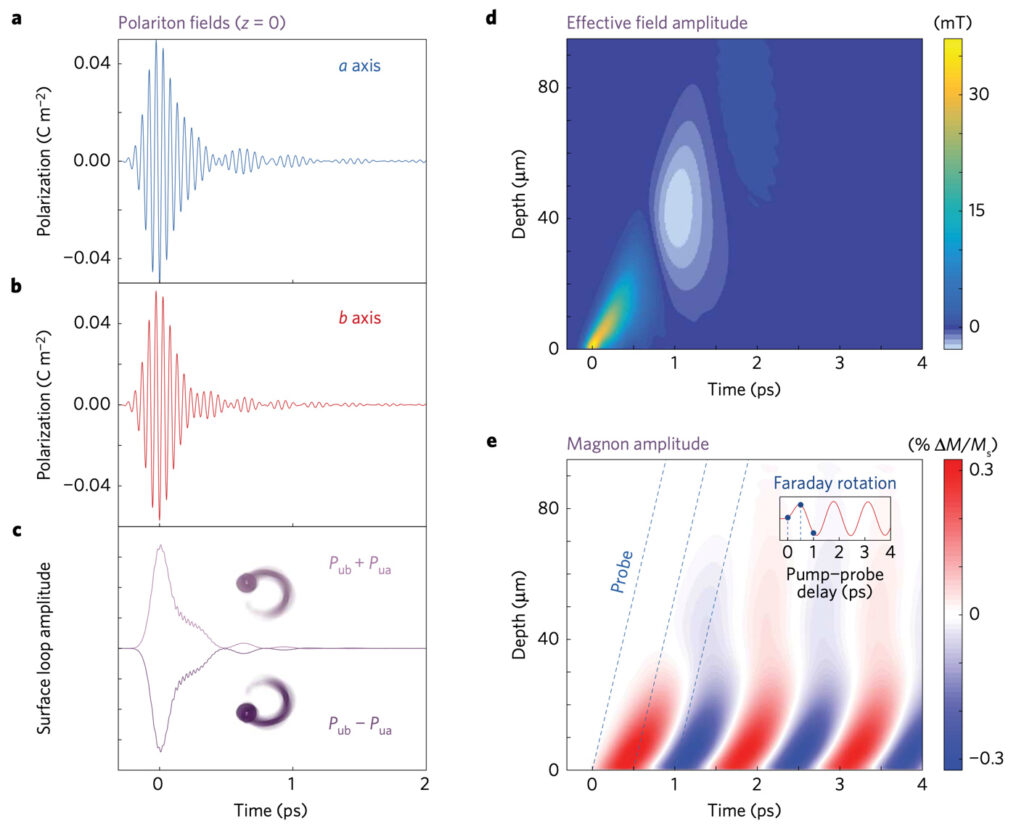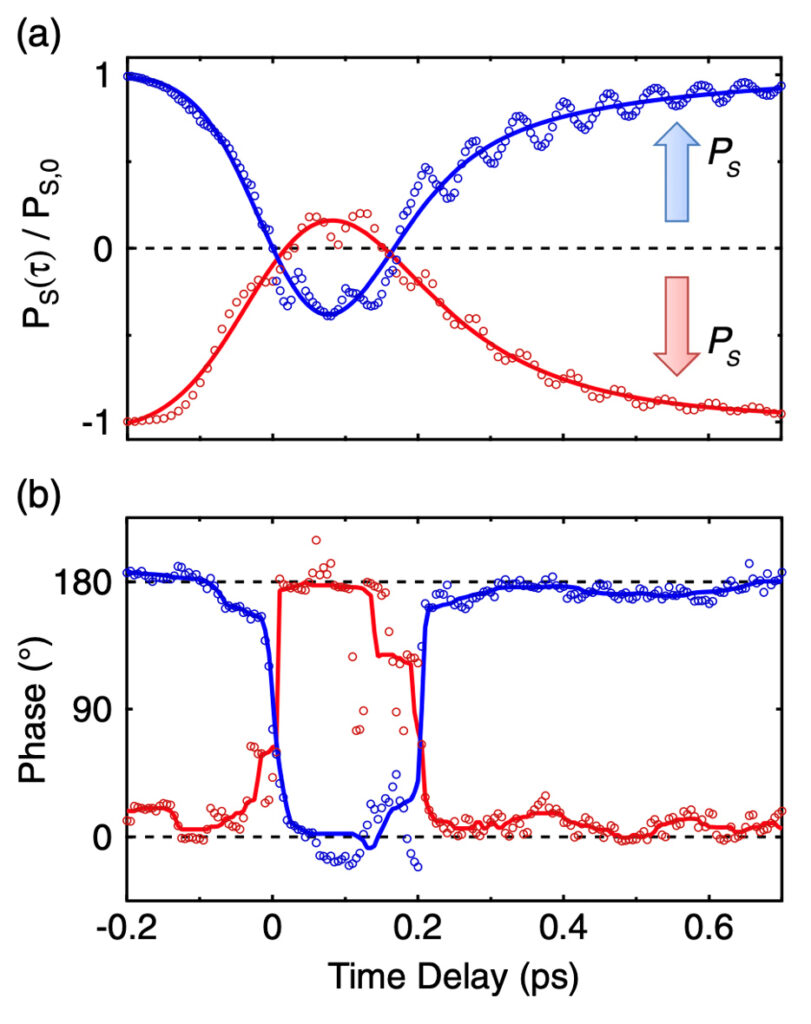Ferroic orders are fascinating manifestations of microscopic quantum mechanical interactions that become visible at macroscopic scales. The order parameter characteristic of ferroics is scientifically intriguing and highly functional, making them central to research and many modern technological applications. Our research focuses on the manipulation and creation of ferroic order on picosecond time scales. We use THz pulses to selectively excite phonons to manipulate the free energy surface underlying the order. We often use nonlinear phonon processes to create new microenvironments. So far, we have successfully demonstrated this approach in ultrafast manipulation of ferroelectric order, polarisation of antiferromagnets and stabilisation of ferromagnetism.
Key publications
Quenched lattice fluctuations in optically driven SrTiO3
M. Fechner, M. Först, G. Orenstein, V. Krapivin, A. Disa, M. Buzzi, A. von Hoegen, G. de la Pena, Q. L. Nguyen, R. Mankowsky, M. Sander, H. Lemke, Y. Deng, M. Trigo, A. Cavalleri
Nature Materials, 23, 363–368 (2024)
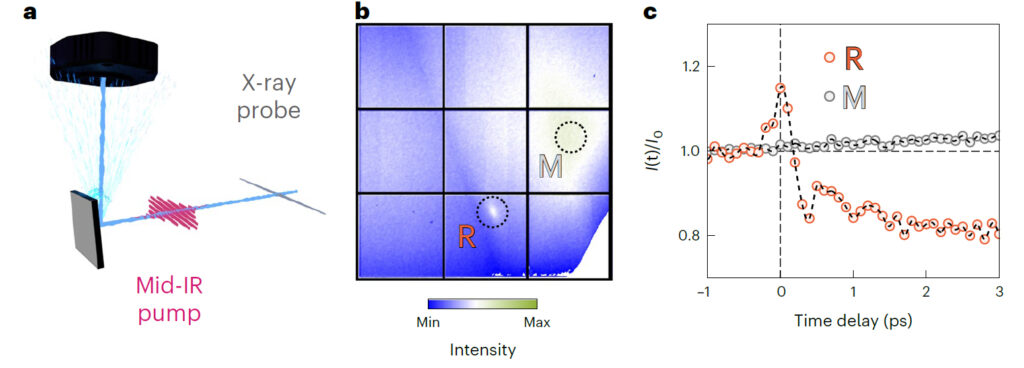
Abstract:
Crystal lattice fluctuations, which are known to influence phase transitions of quantum materials in equilibrium, are also expected to determine the dynamics of light-induced phase changes. However, they have only rarely been explored in these dynamical settings. Here we study the time evolution of lattice fluctuations in the quantum paraelectric SrTiO3, in which mid-infrared drives have been shown to induce a metastable ferroelectric state. Crucial in these physics is the competition between polar instabilities and antiferrodistortive rotations, which in equilibrium frustrate the formation of long-range ferroelectricity. We make use of high-intensity mid-infrared optical pulses to resonantly drive the Ti–O-stretching mode at 17 THz, and we measure the resulting change in lattice fluctuations using time-resolved X-ray diffuse scattering at a free-electron laser. After a prompt increase, we observe a long-lived quench in R-point antiferrodistortive lattice fluctuations. Their enhancement and reduction are theoretically explained by considering the fourth-order nonlinear phononic interactions to the driven optical phonon and third-order coupling to lattice strain, respectively. These observations provide a number of testable hypotheses for the physics of light-induced ferroelectricity.
Photo-induced high-temperature ferromagnetism in YTiO3
A. S. Disa, J. Curtis, M. Fechner, A. Liu, A. von Hoegen, M. Först, T. F. Nova, P. Narang, A. Maljuk, A. V. Boris, B. Keimer & A. Cavalleri
Nature, 617, 73–78 (2023)
Abstract
In quantum materials, degeneracies and frustrated interactions can In quantum materials, degeneracies and frustrated interactions can have a profound impact on the emergence of long-range order, often driving strong fluctuations that suppress functionally relevant electronic or magnetic phases. Engineering the atomic structure in the bulk or at heterointerfaces has been an important research strategy to lift these degeneracies, but these equilibrium methods are limited by thermodynamic, elastic and chemical constraints. Here we show that all-optical, mode-selective manipulation of the crystal lattice can be used to enhance and stabilize high-temperature ferromagnetism in YTiO3, a material that shows only partial orbital polarization, an unsaturated low-temperature magnetic moment and a suppressed Curie temperature, Tc = 27 K. The enhancement is largest when exciting a 9 THz oxygen rotation mode, for which complete magnetic saturation is achieved at low temperatures and transient ferromagnetism is realized up to Tneq > 80 K, nearly three times the thermodynamic transition temperature. We interpret these effects as a consequence of the light-induced dynamical changes to the quasi-degenerate Ti t2g orbitals, which affect the magnetic phase competition and fluctuations found in the equilibrium state. Notably, the light-induced high-temperature ferromagnetism discovered in our work is metastable over many nanoseconds, underscoring the ability to dynamically engineer practically useful non-equilibrium functionalities.
Engineering crystal structures with light
A. S. Disa, T. F. Nova and A. Cavalleri
Nature Physics, 17, 1087-1092 (2021)
Abstract
The crystal structure of a solid largely dictates its electronic, optical and mechanical properties. Indeed, much of the exploration of quantum materials in recent years including the discovery of new phases and phenomena in correlated, topological and two-dimensional materials—has been based on the ability to rationally control crystal structures through materials synthesis, strain engineering or heterostructuring of van der Waals bonded materials. These static approaches, while enormously powerful, are limited by thermodynamic and elastic constraints. An emerging avenue of study has focused on extending such structural control to the dynamical regime by using resonant laser pulses to drive vibrational modes in a crystal. This paradigm of ‘nonlinear phononics’ provides a basis for rationally designing the structure and symmetry of crystals with light, allowing for the manipulation of functional properties at high speed and, in many instances, beyond what may be possible in equilibrium. Here we provide an overview of the developments in this field, discussing the theory, applications and future prospects of optical crystal structure engineering.
Polarizing an antiferromagnet by optical engineering of the crystal field
A. S. Disa, M. Fechner, T. F. Nova, B. Liu, M. Först, D. Prabhakaran, P. G. Radaelli, A. Cavalleri
Nature Physics 16, 937–941 (2020)
Abstract
Strain engineering is widely used to manipulate the electronic and magnetic properties of complex materials. For example, the piezomagnetic effect provides an attractive route to control magnetism with strain. In this effect, the staggered spin structure of an antiferromagnet is decompensated by breaking the crystal field symmetry, which induces a ferrimagnetic polarization. Piezomagnetism is especially appealing because, unlike magnetostriction, it couples strain and magnetization at linear order, and allows for bi-directional control suitable for memory and spintronics applications. However, its use in functional devices has so far been hindered by the slow speed and large uniaxial strains required. Here we show that the essential features of piezomagnetism can be reproduced with optical phonons alone, which can be driven by light to large amplitudes without changing the volume and hence beyond the elastic limits of the material. We exploit nonlinear, three-phonon mixing to induce the desired crystal field distortions in the antiferromagnet CoF2. Through this effect, we generate a ferrimagnetic moment of 0.2 μB per unit cell, nearly three orders of magnitude larger than achieved with mechanical strain.
Metastable ferroelectricity in optically strained SrTiO3
T. Nova, A. Disa, M. Fechner, A. Cavalleri
Science, 364, 1075-1079 (2019)
Abstract
Fluctuating orders in solids are generally considered high-temperature precursors of broken symmetry phases. However, in some cases, these fluctuations persist to zero temperature and prevent the emergence of long-range order. Strontium titanate (SrTiO3) is a quantum paraelectric in which dipolar fluctuations grow upon cooling, although a long-range ferroelectric order never sets in. Here, we show that optical excitation of lattice vibrations can induce polar order. This metastable polar phase, observed up to temperatures exceeding 290 kelvin, persists for hours after the optical pump is interrupted. Furthermore, hardening of a low-frequency vibration points to a photoinduced ferroelectric phase transition, with a spatial domain distribution suggestive of a photoflexoelectric coupling.
An effective magnetic field from optically driven phonons
T. F. Nova, A. Cartella, A. Cantaluppi, M. Först, D. Bossini, R. V. Mikhaylovskiy, A. V. Kimel, R. Merlin, A. Cavalleri
Nature Physics, 13, 132–136 (2017)
Abstract
Light fields at terahertz and mid-infrared frequencies allow for the direct excitation of collective modes in condensed matter, which can be driven to large amplitudes. For example, excitation of the crystal lattice has been shown to stimulate insulator–metal transitions melt magnetic order or enhance superconductivity. Here, we generalize these ideas and explore the simultaneous excitation of more than one lattice mode, which are driven with controlled relative phases. This nonlinear mode mixing drives rotations as well as displacements of the crystal-field atoms, mimicking the application of a magnetic field and resulting in the excitation of spin precession in the rare-earth orthoferrite ErFeO3. Coherent control of lattice rotations may become applicable to other interesting problems in materials research—for example, as a way to a!ect the topology of electronic phases.
Ultrafast reversal of the ferroelectric polarization
R. Mankowsky, A. von Hoegen, M. Först, A. Cavalleri
Physical Review Letters, 118, 197601 (2017)
Abstract
We report on the demonstration of ultrafast optical reversal of the ferroelectric polarization in LiNbO3. Rather than driving the ferroelectric mode directly, we couple to it indirectly by resonant excitation of an auxiliary high-frequency phonon mode with femtosecond midinfrared pulses. Because of strong anharmonic coupling between these modes, the atoms are directionally displaced along the ferroelectric mode and the polarization is transiently reversed, as revealed by time-resolved, phase-sensitive, secondharmonic generation. This reversal can be induced in both directions, a key prerequisite for practical applications.

